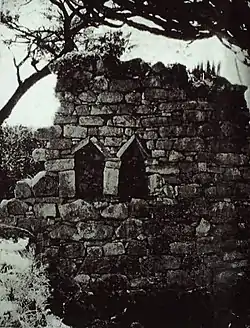Amud
Amud or Amoud (Somali: Camuud, Arabic: عمود) is an ancient, ruined town in the Awdal region of Somaliland.[1] Named after its patron Saint Amud[2] it was a center of activity during the Golden Age of the Adal Kingdom. The archaeological site is situated 1,000 metres (3,300 ft) above sea level, around 10 km southeast of the regional capital Borama.[3][4]
Amud | |
|---|---|
Archaeological site | |
 Triangular headed niches in the wall of an old uninhabited house at Amud | |
.svg.png.webp) Amud Location in Somalia | |
| Coordinates: 9°59′57″N 43°13′56″E | |
| Country | |
| Region | Awdal |
| Time zone | UTC+3 (EAT) |
Overview
The historian G.W.B. Huntingford (1930) gives a detailed description of the ancient town in The town of Amud, Somaliland:
"The house are scattered around without any apparent plan; there are no streets and no trace of a surrounding wall. There is a mosque in the southern half of the dwelling area... [with a] rather oddly built mihrab facing the entrance... and immediately to the south... is the cemetery. There are upwards of two hundred houses, all well-built of stone [and] as much as 2.6m in height... The number of rooms ranges from two to four... there is sometimes no sign of an entrance to the inner rooms. This implies that entry was made from the roof, which was doubtless flat and reached by teps now vanished... There are many niches or cupboards in the inner walls."[5]
The old section of Amud spans 25 acres (100,000 m2) and contains hundreds of ancient ruins of multi-roomed courtyard houses, stone walls, complex mosques, and other archaeological remains, including intricate colored glass bracelets and Chinese ceramics.[6]
According to Sonia Mary Cole, the town features 250 to 300 houses and an ancient temple. The temple was constructed from carefully dressed stone, and was later transformed into a mosque. It also features pottery lamps. Altogether, the building techniques, among other factors, point to a close association with Aksumite archaeological sites from the 2nd to 5th centuries AD.[7]
Amud is home to several historic pilgrimage sites belonging to celebrated Somali Saints, the most prominent being Saint Sau, Saint Amud and Saint Sharlagamadi. During his research in the area, the historian G.W.B. Huntingford noticed that whenever a historic site had the prefix Aw in its name (such as the ruins of Awbare and Awbube), it denoted the final resting place of a local Saint.[4] The patron Saint Amud is buried in the vicinity of the ancient town.[8]
The Amoud University in Borama is named after the archaeological site.
Demographics

The region around the ancient town and university is inhabited by the Faarah Nuur, one of the two sub divisions of Reer Nuur, a subclan of the Gadabuursi Dir clan.[9]
See also
Notes
- Damtew Teferra, African higher education: an international reference handbook, (Indiana University Press: 2003)
- Somaliland: With Addis Ababa and Eastern Ethiopia
- Somaliland: With Addis Ababa and Eastern Ethiopia, p. 148
- Huntingford, "The town of Amud, Somalia", Azania, 13 (1978), p. 184
- Briggs, Philip (2012). Somaliland: with the overland route from Addis Ababa via eastern Ethiopia (1st ed.). ISBN 9781784776053.
The house are scattered around without any apparent plan; there are no streets and no trace of a surrounding wall. There is a mosque in the southern half of the dwelling area... [with a] rather oddly built mihrab facing the entrance... and immediately to the south... is the cemetery. There are upwards of two hundred houses, all well-built of stone [and] as much as 2.6m in height... The number of rooms ranges from two to four... there is sometimes no sign of an entrance to the inner rooms. This implies that entry was made from the roof, which was doubtless flat and reached by teps now vanished... There are many niches or cupboards in the inner walls.
- The Archaeology of Islam in Sub Saharan Africa, p. 72/73
- Cole, Sonia Mary (1964). The Prehistory of East Africa. Weidenfeld & Nicolson. p. 275.
- Somaliland: With Addis Ababa and Eastern Ethiopia,
- Hayward, R. J.; Lewis, I. M. (2005-08-17). Voice and Power. Routledge. ISBN 9781135751753.